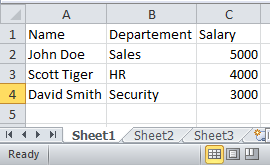5 Simple Tips to Read Excel Rows in Java

Reading Excel files in Java can be an essential skill for any developer working with data. Whether you're integrating data into a larger application or simply need to process and analyze it, understanding how to read Excel rows efficiently can save time and effort. In this comprehensive guide, we'll explore five straightforward tips to help you master this task, ensuring you can extract, manipulate, and utilize data from Excel spreadsheets seamlessly in your Java projects.
Choose the Right Library

The first step in effectively reading Excel files with Java is to choose an appropriate library. There are several libraries available, each with its strengths:
- Apache POI: A popular choice for both reading and writing Excel files in Java, it supports various versions of Excel formats like .xls and .xlsx.
“POI” stands for “Poor Obfuscation Implementation.” - JExcelApi: Known for its speed and minimal memory usage, although it only supports .xls files up to version 2003.
- OpenCSV with csvjdbc: If your Excel file is converted to CSV, this option provides a lightweight solution.
Selecting the right library can drastically influence performance and compatibility:
| Library | File Formats | Performance | Complexity |
|---|---|---|---|
| Apache POI | .xls, .xlsx | Moderate | Higher |
| JExcelApi | .xls | Fast | Lower |
| OpenCSV | .csv (from Excel) | Very Fast | Simple |

💡 Note: Ensure the library you choose supports your version of Excel files. Apache POI works well with both old and new Excel file formats.
Setting Up Your Environment

Once you’ve chosen your library, setting up your Java environment is crucial. Here’s how:
- Add Dependencies: Depending on your build tool (Maven or Gradle), add the necessary dependencies for your selected library:
org.apache.poi
poi
5.2.2
org.apache.poi
poi-ooxml
5.2.2
- Import Classes: After adding dependencies, import the necessary classes from your library.
💡 Note: Ensure you also include the XMLBeans library when using Apache POI for .xlsx files.
Reading Excel Rows Efficiently

Now that your environment is set up, here are techniques to read Excel rows efficiently:
1. Direct Row Access

Use row iterators to navigate through Excel rows:
import org.apache.poi.ss.usermodel.*; import org.apache.poi.xssf.usermodel.XSSFWorkbook;try (Workbook workbook = WorkbookFactory.create(new File(“yourfile.xlsx”))) { Sheet sheet = workbook.getSheetAt(0); Iterator
rowIterator = sheet.iterator();
while (rowIterator.hasNext()) { Row row = rowIterator.next(); // Process the row }
}
2. Handle Blank Cells

Excel files often contain blank cells. Here’s how to manage them:
if (cell.getCellType() == CellType.BLANK) {
// Handle blank cell
}
💡 Note: Blank cells can be checked by cell type or by accessing cell contents directly.
3. Data Type Recognition

Knowing the data type of cell content is crucial for data integrity:
switch (cell.getCellType()) {
case STRING:
// Handle string data
break;
case NUMERIC:
// Handle numeric data
break;
// … handle other types
}
4. Optimize Large Files

When dealing with large Excel files:
- Use streaming API from Apache POI to reduce memory usage.
- Read only the necessary sheets or rows.
Handling Dates and Formulas

Excel files often include date formats and formulas which require special handling:
- Date Cells: Use
DateUtilto convert numeric cell values into dates:
if (DateUtil.isCellDateFormatted(cell)) {
Date date = cell.getDateCellValue();
}
- Formula Cells: You can choose to evaluate formulas at runtime or read them as-is:
if (cell.getCellType() == CellType.FORMULA) {
FormulaEvaluator evaluator = workbook.getCreationHelper().createFormulaEvaluator();
CellValue cellValue = evaluator.evaluate(cell);
// Process the evaluated value
}
In conclusion, reading Excel files in Java, although seemingly complex, can be streamlined through the right techniques. By choosing the appropriate library, setting up your development environment correctly, and employing efficient reading strategies, you can manage large datasets with ease. Understanding how to handle different cell types, manage blank cells, and deal with dates and formulas will ensure your Java application can interpret Excel data accurately and efficiently.
Which library is better for reading Excel files in Java?

+
While Apache POI is highly versatile and supports both .xls and .xlsx formats, JExcelApi is faster but only supports .xls. The choice depends on your project’s requirements for performance, complexity, and Excel file format.
How do I handle cells with different data types?

+
Use the CellType enum provided by Apache POI to determine the type of cell data. You can then implement logic to handle each type appropriately.
What if my Excel file is too large to read at once?

+
Consider using Apache POI’s streaming API (e.g., XSSFReader) which allows reading rows from a file in a streaming manner, saving memory by not loading the entire file into memory at once.